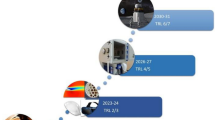Abstract—The paper analyzes the Russian scientific and technological capabilities to manufacture a space-borne observation platform for high-precision monitoring of the Earth’s gravitational field. It is shown that some Russian space systems manufacturing technologies may well be used for this purpose; however, in general, the level of the domestic technologies must be substantially improved so as to meet stringent requirements of such a project. Nevertheless, it can be confidently stated that it is quite feasible to carry out this project using Russian technologies.




Similar content being viewed by others
REFERENCES
Albertella, A., Migliaccio, F., and Sanso, F., GOCE: The Earth gravity field by space gradiometry, Celest. Mech. Dyn. Astron., 2002, no. 83, pp. 1–15. https://doi.org/10.1023/A:1020104624752
AO Morion. http://www.morion.com.ru/rus/. Accessed April 1, 2019.
AO Morion. Rubidium Generators. http://www.morion.com.ru/rus/rb/. Accessed April 1, 2019.
Auger, G., et al., LISA-like laser ranging for GRACE Follow-On, 59th LISA Symposium, ASP Conference Series, Paris, 2012, vol. 467.
Bai, Y., et al., Research and development of electrostatic accelerometers for space science missions at HUST, Sensors, 2017, no. 17, pp. 19–43. https://doi.org/10.3390/s17091943
Demidov, N.A., Belyaev, A.A., Sakharov, B.A., Prospective onboard hydrogen frequency standard for space applications, in VIII International Symposium Metrology of Time and Space, St. Petersburg, 2016, p. 41.
Gerhard., H., Satellite interferometry from LTP and GRACE Follow-On to LISA, LISA Symposium, Zürich, 2016. https://pdfs.semanticscholar.org/presentation/df7e/ece0df094cdb3c5b9bcfd370942709fffc0e.pdf. Accessed April 1, 2019.
Gerhard, H., et al., Laser ranging interferometer for GRACE Follow-On, J. Phys. Conf. Ser., 2015, vol. 610, no. 1. https://doi.org/10.1117/12.2309099
Gerhard, H., et al., Laser ranging interferometer for GRACE Follow-On, Proc. SPIE 10564, International Conference on Space Optics, 2017, vol. 1056420. https://doi.org/10.1117/12.2309099
Laser Interferometer Space Antenna (LISA) Measurement Requirements Flowdown Guide. LISA Project internal report number LISA-MSE-TN-0001, Washington, DC: Natl. Aeronaut. Space Admin., 2009.
Lavochkin Association. Fregat Multipurpose Booster. http://www.laspace.ru/company/products/launchvehicles/fregat/. Accessed April 1, 2019.
Luo, J., et al. TianQin: A space-borne gravitational wave detector, Class. Quantum Grav., 2016, vol. 33, no. 3, art. ID 035010. https://doi.org/10.1088/02649381/33/3/035010
Miniature precision low-noise quartz generator GK333M-TS. http://www.morion.com.ru/catalog_pdf/NEW-ГK333M_BEP_1.pdf. Accessed April 1, 2019.
MOKB Mars. http://www.mars-mokb.ru/index.html. Accessed April 1, 2019.
NPP Geofizika Cosmos. http://www.geofizika-cosmos.ru/. Accessed April 1, 2019.
OOO Azmerit. http://www.azmerit.ru. Accessed April 1, 2019.
OOO Gaskol. http://www.gaskol.ru. Accessed April 1, 2019.
Reigber, C., et al., An Earth gravity field model complete to degree and order 150 from GRACE: EIGENGRACE02S, J. Geodyn., 2005, no. 39, pp. 1–10.
Reigber, C., Luehr, H., and Schwintzer, P., CHAMP mission status, J. Adv. Space Res., 2002, vol. 30, no. 2, pp. 129–134.
Roscosmos. Soyuz-2 Launch Vehicle. http://www.roscosmos.ru/468/. Accessed April 1, 2019. Schütze, D., GRACE Follow-On laser ranging interferometer, Quantum to Cosmos 5, Cologne, Germany, 2012. http://www.zarm.unibremen.de/Q2C5/pdf/presentations/Schuetze_GRACE.pdf. Accessed April 1, 2019.
Sutton, A., DI ranging for the GRACEFO laser ranging interferometer. Jet Propulsion Laboratory, California Institute of Technology. http://www.physics.ufl.edu/ lisasymposiumx/resources/contributions/Th4b_2_Sutton.pdf. Accessed April 1, 2019.
Tapley, B.D., Bettadpur, S., Watkins, M.M., and Reigber, Ch., The gravity recovery and climate mission overview and early results, Geophys. Rev. Lett., 2004, vol. 31, no. 9, id. L09607. https://doi.org/10.1029/2004GL019920
Touboul, P., Willemenot, E., Foulon, B., and Josselin, V., Accelerometers for CHAMP, GRACE and GOCE space missions: Synergy and evolution, Boll. Geofis. Teor. Appl., 1999, nos. 3–4, pp. 321–327.
Unified Procurement Information System. http://www. zakupki.gov.ru/epz/order/notice/ok44/view/documents.html?regNumber = 0995000000216000045. Accessed April 1, 2019.
Vasil’ev, V.P. and Shargorodskii, V.D., The current state of high-precision satellite laser ranging in Russia, Fotonika, 2017, no. 6, pp. 74–85.
Zuber, M.T., Smith, D.E., Watkins, M.M., et al., Gravity field of the Moon from the Gravity Recovery And Interior Laboratory (GRAIL) mission, Science, 2013, pp. 668–671. https://doi.org/10.1126/science.1231507
Funding
This work was performed under government contract no. 851-0323/16/258, November 28, 2016, between the Roskosmos State Corporation and TsNIImash, supported by the Russian Foundation for Basic Research, grant no. 19-29-11008).
Author information
Authors and Affiliations
Corresponding authors
Additional information
Translated by B. Shubik
Rights and permissions
About this article
Cite this article
Milyukov, V.K., Burdanov, A.V., Zhamkov, A.S. et al. Analysis of Key Technologies for a Space Geophysics Mission: Required Accuracies and Engineering Solutions. Sol Syst Res 54, 610–620 (2020). https://doi.org/10.1134/S003809462007014X
Received:
Revised:
Accepted:
Published:
Issue Date:
DOI: https://doi.org/10.1134/S003809462007014X



